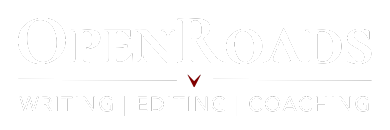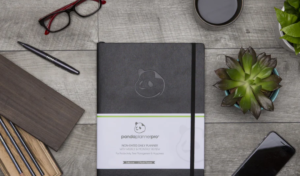As writers, we thrive on flow and getting time in our seats—but staying organized and protecting our time can be challenging.
Whether you’re drafting your next novel or juggling multiple projects, the best planners for writers help establish guilt-free boundaries that allow you to write more and prioritize your craft without distractions.
This guide highlights three exceptional options for writers and explores how intentional planning transforms the writing process. Plus, discover how planning helped Sven create a system that propelled his work forward.
Why Writers Need Planners
Writing requires time, focus, and intention. Too often, the lines between “work” and “life” blur, leaving creative time vulnerable to distractions and competing priorities. Many writers struggle to balance their goals with other demands, leading to sporadic progress and unfinished manuscripts.
Without a system to protect creative time, writing easily falls by the wayside.
Take Sven, for example. He approached his writing projects with the mindset of, “I’ll get to it when I have time.” But this ad-hoc method left him frustrated and stuck. After months of transcribing interviews, he realized he hadn’t made any progress on his manuscript—a project he cared deeply about but couldn’t seem to prioritize.
In a coaching session, we created a plan to shift his approach. Together, we built a system that gave his writing the space it needed, free from guilt or interruptions.
Sven began dedicating time each Sunday to map out his week, breaking his workload into focused blocks: conducting interviews, transcribing notes, and, most importantly, writing his book. With clear boundaries and intentional planning, Sven transformed his progress and established a routine that honored his craft.
Which planner helped him make a game-changing switch? Read on.
Best Planners for Writers: Top Choices
#3. Moleskine Planner
The Moleskine Planner is perfect for writers who value simplicity and elegance. Its clean design provides the structure needed to establish guilt-free boundaries and focus on creative work.
Why It’s a Great Option:
Moleskine planners offer a minimalist approach ideal for brainstorming and scheduling without overwhelming distractions. The various formats—daily, weekly, or monthly—allow writers to tailor their plans to their unique needs. Durable and inspiring, they’re perfect for setting boundaries and dedicating time to writing goals.
Pros:
- Available in various sizes and formats to match different planning styles.
- Durable cover and high-quality paper ensure it withstands daily use.
- Minimalist design provides a clean slate for brainstorming and planning.
Cons:
- Less customizable compared to bullet journals.
- Pricier than other planners, which might deter budget-conscious writers.
- Minimalist layouts may lack features like guided prompts.
- Doesn’t leverage positive psychology to encourage daily recomittment.
#2. Bullet Journal
For writers who crave flexibility and creativity, the Bullet Journal offers endless possibilities. This customizable system allows writers to design layouts that protect their time and creative energy.
Why It’s a Great Option:
The bullet journal is perfect for writers who want complete control over their planning process. Whether tracking writing projects or setting deadlines for submissions, writers can use the dot-grid layout to design personalized systems that align with their goals. Its flexibility encourages guilt-free boundaries, allowing writers to prioritize their work without sacrificing creative freedom.
Pros:
- Fully customizable, allowing writers to create a system that works for them.
- Ideal for tracking writing projects, brainstorming ideas, and creative layouts.
- Can double as a creative outlet with artistic spreads or thematic designs.
Cons:
- Requires time and effort to set up, which may not suit busy writers.
- Lacks pre-defined prompts and templates, which some writers might find overwhelming.
- Success depends on your ability to maintain and adapt the system.
- Doesn’t leverage positive psychology to encourage daily recomittment.
#1. Panda Planner Pro (Top Recommended)
The best planner for writers? Hands down. It’s the Panda Planner Pro. It helps writers stay focused, productive, and positive. Its features support guilt-free boundaries and encourage consistent progress toward writing goals.
Why It’s a Great Option:
This planner uses principles of positive psychology and neuroscience, making it an excellent choice for writers who want to boost creativity while building productive habits. Gratitude, goal-setting, and reflection sections allow writers to maintain focus while celebrating their strengths. Its structured layout helps writers carve out dedicated time for their craft, fostering guilt-free routines that lead to consistent progress and publishing success.
Pros:
- Encourages positive psychology and motivation through gratitude and reflection.
- Undated format gives writers flexibility to start at any time.
- Sections for priorities and goals help writers create actionable plans.
- Comes with bonus resources, like eBooks and a productivity video mini-course.
Cons:
- Covers only three months, so you’ll need to replace it multiple times a year.
- Structured format may feel restrictive compared to a bullet journal.
- Slightly bulkier than minimalist planners like Moleskine.
My Experience with Planners as a Writer
Over the years, I’ve explored different planners to find the best fit for my writing process.
I started with a Bullet Journal, drawn to its flexibility and creativity. For two years, I loved designing layouts tailored to my writing projects, tracking progress, and exploring new ways to organize ideas.
It was an excellent tool for personalization and creative freedom, but over time, I found it difficult to keep up with the constant setup. Every time I ran out of paper, I had to create a new Bullet Journal from scratch, which became too time-consuming during busy seasons.
I also used a Moleskine Planner for a while, and there’s no denying its charm. The feel of the planner and the literary legacy of the Moleskine brand made it a joy to use. As a writer, I felt a sense of connection to the great minds who have relied on Moleskine products over the years.
However, while I appreciated its elegance and simplicity, it lacked the positive psychology integrations I needed during times of waning motivation. Without prompts for gratitude, reflection, or actionable goal-setting, I often found myself struggling to stay focused and believing in my ability to make progress.
Eventually, I made the switch to the Panda Planner Pro, and it transformed the way I approach my writing and my time. I’ve been using it for several years now, and it has become an indispensable part of my creative process. The structure and positive psychology built into the planner keep me grounded during periods of low energy or hectic schedules.
It helps me stay focused with guilt-free intention—not just on my writing, but on the habits and activities that allow me to thrive as a writer. I’ve come to see the Panda Plan as more than my planner, but as a critical mindset tool that supports my growth and productivity.
How to Choose the Best Planner for Writers
The best planners for writers help you write more while protecting your time. Here’s a quick guide:
- If you thrive on structure and positivity, the Panda Planner Pro is the ideal choice for guilt-free progress.
- For writers who love simplicity and professionalism, the Moleskine Planner provides a clean slate for focused work.
- If creativity and personalization are key, the Bullet Journal allows endless flexibility to suit your needs.
Conclusion
Writing requires time, focus, and commitment, yet protecting that time can often feel like a challenge.
The best planners for writers establish guilt-free boundaries and prioritize your craft. Planning creates a system that transforms intentions into results.
A planner like the Panda Planner Pro helps writers tap into strengths, foster positive habits, and turn every writing session into meaningful progress. Gratitude, goal-setting, and reflection equip writers to honor their work while making steady strides toward publishing success.
Intentional planning allows you to write more, with clarity and satisfaction, knowing you’ve set boundaries that make your creative time truly productive. Choose the right planner and take the first step toward protecting your craft and achieving your writing goals. Start transforming your writing journey today.Let me know if this version aligns with your vision!



